Analysis of the Emerging or Recreational Agricultural Olive Industry
VerifiedAdded on 2023/01/06
|6
|1253
|81
Report
AI Summary
This report provides an overview of the emerging olive industry, focusing on its significance and the economic impact. It details the location, size, and production of olives, particularly in Australia. The report explores the advantages, such as food production and employment opportunities, and limitations, including pollution and the decline in quality due to technological advancements. It compares the olive industry to traditional sectors in Australia, highlighting the impact of new technologies and planting techniques. The report concludes with suggestions for maintaining the natural and organic qualities of olives, advocating for the promotion of organic farming. The report includes references to various books and journals that support the findings of the analysis.
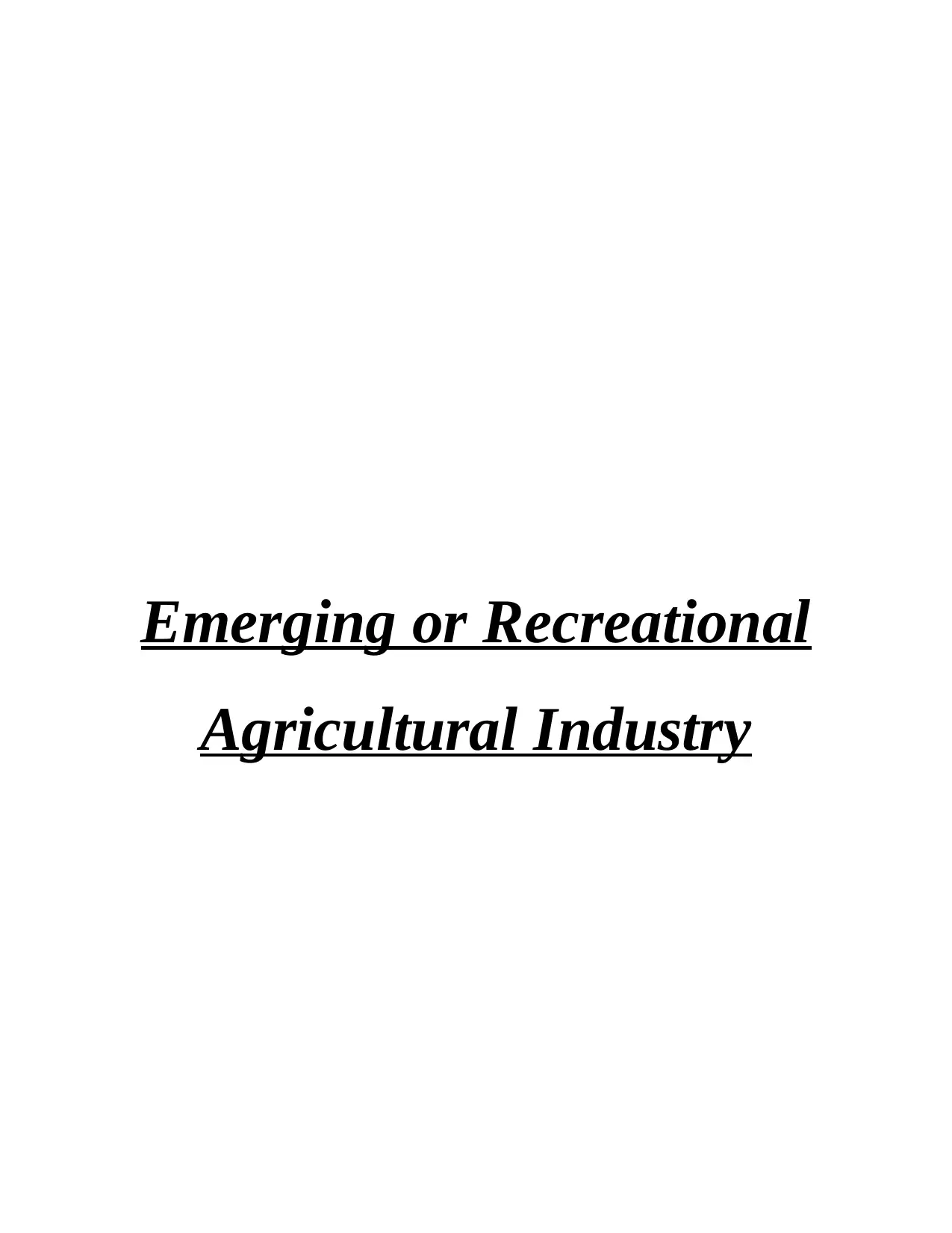
Emerging or Recreational
Agricultural Industry
Agricultural Industry
Paraphrase This Document
Need a fresh take? Get an instant paraphrase of this document with our AI Paraphraser
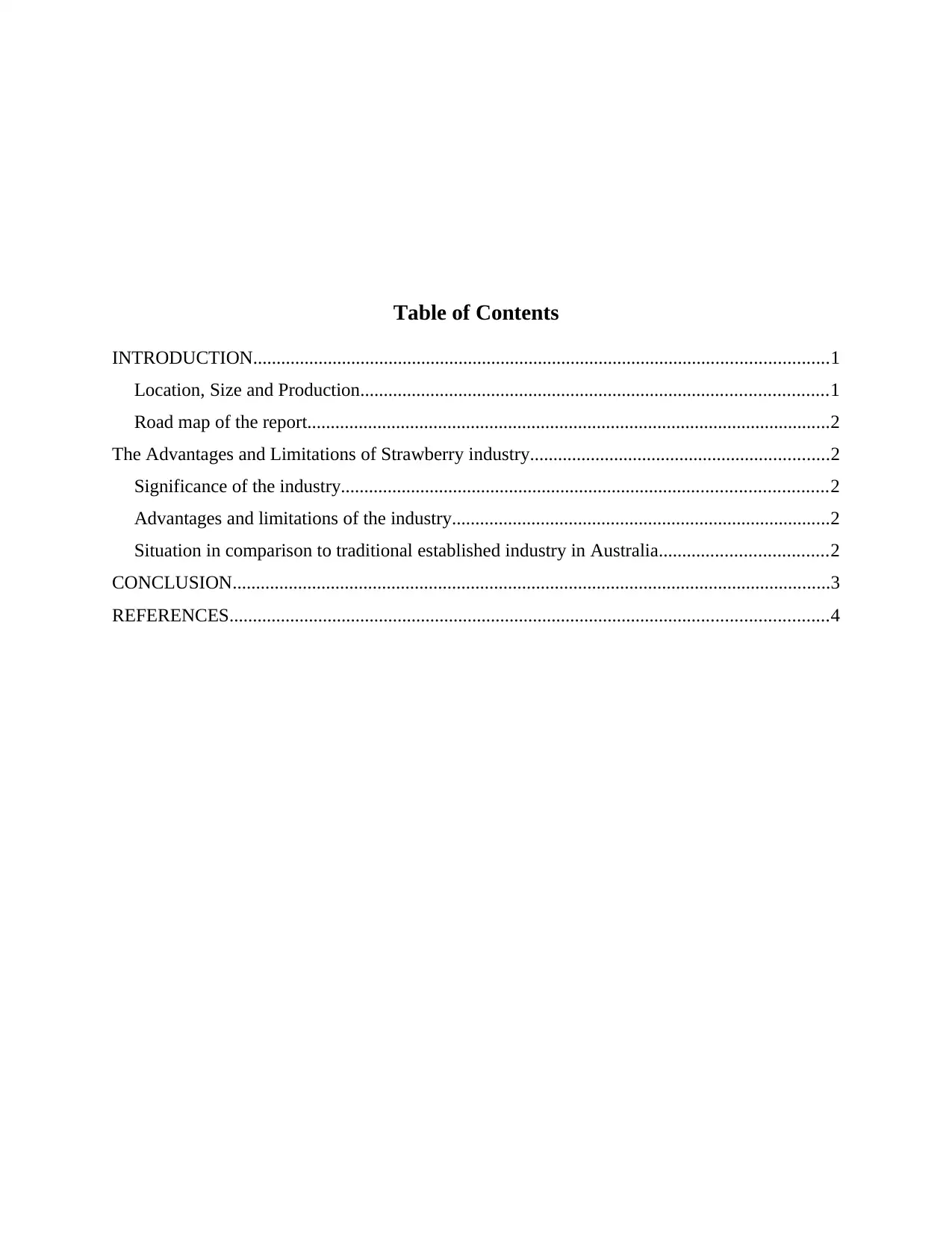
Table of Contents
INTRODUCTION...........................................................................................................................1
Location, Size and Production....................................................................................................1
Road map of the report................................................................................................................2
The Advantages and Limitations of Strawberry industry................................................................2
Significance of the industry........................................................................................................2
Advantages and limitations of the industry.................................................................................2
Situation in comparison to traditional established industry in Australia....................................2
CONCLUSION................................................................................................................................3
REFERENCES................................................................................................................................4
INTRODUCTION...........................................................................................................................1
Location, Size and Production....................................................................................................1
Road map of the report................................................................................................................2
The Advantages and Limitations of Strawberry industry................................................................2
Significance of the industry........................................................................................................2
Advantages and limitations of the industry.................................................................................2
Situation in comparison to traditional established industry in Australia....................................2
CONCLUSION................................................................................................................................3
REFERENCES................................................................................................................................4
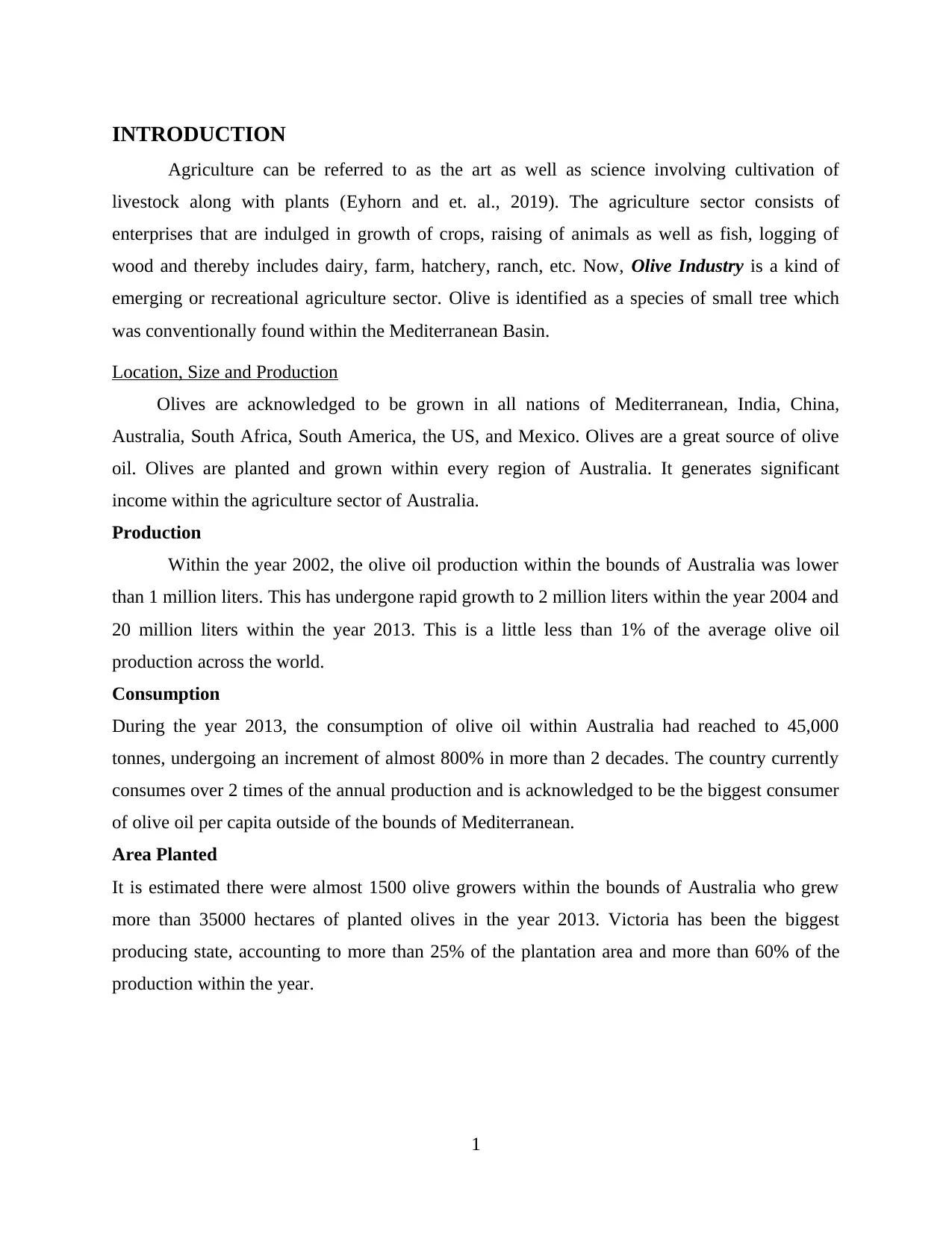
INTRODUCTION
Agriculture can be referred to as the art as well as science involving cultivation of
livestock along with plants (Eyhorn and et. al., 2019). The agriculture sector consists of
enterprises that are indulged in growth of crops, raising of animals as well as fish, logging of
wood and thereby includes dairy, farm, hatchery, ranch, etc. Now, Olive Industry is a kind of
emerging or recreational agriculture sector. Olive is identified as a species of small tree which
was conventionally found within the Mediterranean Basin.
Location, Size and Production
Olives are acknowledged to be grown in all nations of Mediterranean, India, China,
Australia, South Africa, South America, the US, and Mexico. Olives are a great source of olive
oil. Olives are planted and grown within every region of Australia. It generates significant
income within the agriculture sector of Australia.
Production
Within the year 2002, the olive oil production within the bounds of Australia was lower
than 1 million liters. This has undergone rapid growth to 2 million liters within the year 2004 and
20 million liters within the year 2013. This is a little less than 1% of the average olive oil
production across the world.
Consumption
During the year 2013, the consumption of olive oil within Australia had reached to 45,000
tonnes, undergoing an increment of almost 800% in more than 2 decades. The country currently
consumes over 2 times of the annual production and is acknowledged to be the biggest consumer
of olive oil per capita outside of the bounds of Mediterranean.
Area Planted
It is estimated there were almost 1500 olive growers within the bounds of Australia who grew
more than 35000 hectares of planted olives in the year 2013. Victoria has been the biggest
producing state, accounting to more than 25% of the plantation area and more than 60% of the
production within the year.
1
Agriculture can be referred to as the art as well as science involving cultivation of
livestock along with plants (Eyhorn and et. al., 2019). The agriculture sector consists of
enterprises that are indulged in growth of crops, raising of animals as well as fish, logging of
wood and thereby includes dairy, farm, hatchery, ranch, etc. Now, Olive Industry is a kind of
emerging or recreational agriculture sector. Olive is identified as a species of small tree which
was conventionally found within the Mediterranean Basin.
Location, Size and Production
Olives are acknowledged to be grown in all nations of Mediterranean, India, China,
Australia, South Africa, South America, the US, and Mexico. Olives are a great source of olive
oil. Olives are planted and grown within every region of Australia. It generates significant
income within the agriculture sector of Australia.
Production
Within the year 2002, the olive oil production within the bounds of Australia was lower
than 1 million liters. This has undergone rapid growth to 2 million liters within the year 2004 and
20 million liters within the year 2013. This is a little less than 1% of the average olive oil
production across the world.
Consumption
During the year 2013, the consumption of olive oil within Australia had reached to 45,000
tonnes, undergoing an increment of almost 800% in more than 2 decades. The country currently
consumes over 2 times of the annual production and is acknowledged to be the biggest consumer
of olive oil per capita outside of the bounds of Mediterranean.
Area Planted
It is estimated there were almost 1500 olive growers within the bounds of Australia who grew
more than 35000 hectares of planted olives in the year 2013. Victoria has been the biggest
producing state, accounting to more than 25% of the plantation area and more than 60% of the
production within the year.
1
⊘ This is a preview!⊘
Do you want full access?
Subscribe today to unlock all pages.

Trusted by 1+ million students worldwide
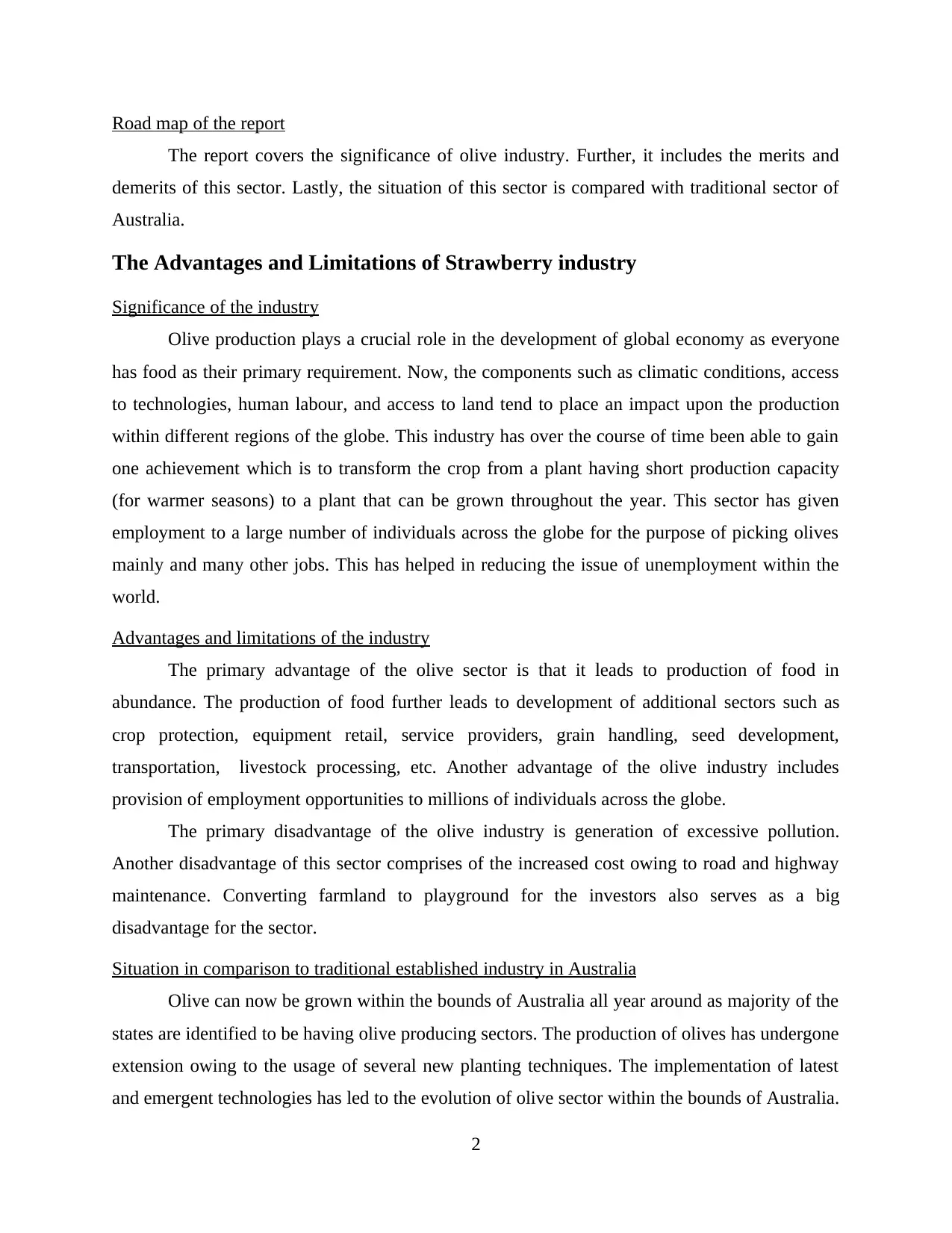
Road map of the report
The report covers the significance of olive industry. Further, it includes the merits and
demerits of this sector. Lastly, the situation of this sector is compared with traditional sector of
Australia.
The Advantages and Limitations of Strawberry industry
Significance of the industry
Olive production plays a crucial role in the development of global economy as everyone
has food as their primary requirement. Now, the components such as climatic conditions, access
to technologies, human labour, and access to land tend to place an impact upon the production
within different regions of the globe. This industry has over the course of time been able to gain
one achievement which is to transform the crop from a plant having short production capacity
(for warmer seasons) to a plant that can be grown throughout the year. This sector has given
employment to a large number of individuals across the globe for the purpose of picking olives
mainly and many other jobs. This has helped in reducing the issue of unemployment within the
world.
Advantages and limitations of the industry
The primary advantage of the olive sector is that it leads to production of food in
abundance. The production of food further leads to development of additional sectors such as
crop protection, equipment retail, service providers, grain handling, seed development,
transportation, livestock processing, etc. Another advantage of the olive industry includes
provision of employment opportunities to millions of individuals across the globe.
The primary disadvantage of the olive industry is generation of excessive pollution.
Another disadvantage of this sector comprises of the increased cost owing to road and highway
maintenance. Converting farmland to playground for the investors also serves as a big
disadvantage for the sector.
Situation in comparison to traditional established industry in Australia
Olive can now be grown within the bounds of Australia all year around as majority of the
states are identified to be having olive producing sectors. The production of olives has undergone
extension owing to the usage of several new planting techniques. The implementation of latest
and emergent technologies has led to the evolution of olive sector within the bounds of Australia.
2
The report covers the significance of olive industry. Further, it includes the merits and
demerits of this sector. Lastly, the situation of this sector is compared with traditional sector of
Australia.
The Advantages and Limitations of Strawberry industry
Significance of the industry
Olive production plays a crucial role in the development of global economy as everyone
has food as their primary requirement. Now, the components such as climatic conditions, access
to technologies, human labour, and access to land tend to place an impact upon the production
within different regions of the globe. This industry has over the course of time been able to gain
one achievement which is to transform the crop from a plant having short production capacity
(for warmer seasons) to a plant that can be grown throughout the year. This sector has given
employment to a large number of individuals across the globe for the purpose of picking olives
mainly and many other jobs. This has helped in reducing the issue of unemployment within the
world.
Advantages and limitations of the industry
The primary advantage of the olive sector is that it leads to production of food in
abundance. The production of food further leads to development of additional sectors such as
crop protection, equipment retail, service providers, grain handling, seed development,
transportation, livestock processing, etc. Another advantage of the olive industry includes
provision of employment opportunities to millions of individuals across the globe.
The primary disadvantage of the olive industry is generation of excessive pollution.
Another disadvantage of this sector comprises of the increased cost owing to road and highway
maintenance. Converting farmland to playground for the investors also serves as a big
disadvantage for the sector.
Situation in comparison to traditional established industry in Australia
Olive can now be grown within the bounds of Australia all year around as majority of the
states are identified to be having olive producing sectors. The production of olives has undergone
extension owing to the usage of several new planting techniques. The implementation of latest
and emergent technologies has led to the evolution of olive sector within the bounds of Australia.
2
Paraphrase This Document
Need a fresh take? Get an instant paraphrase of this document with our AI Paraphraser
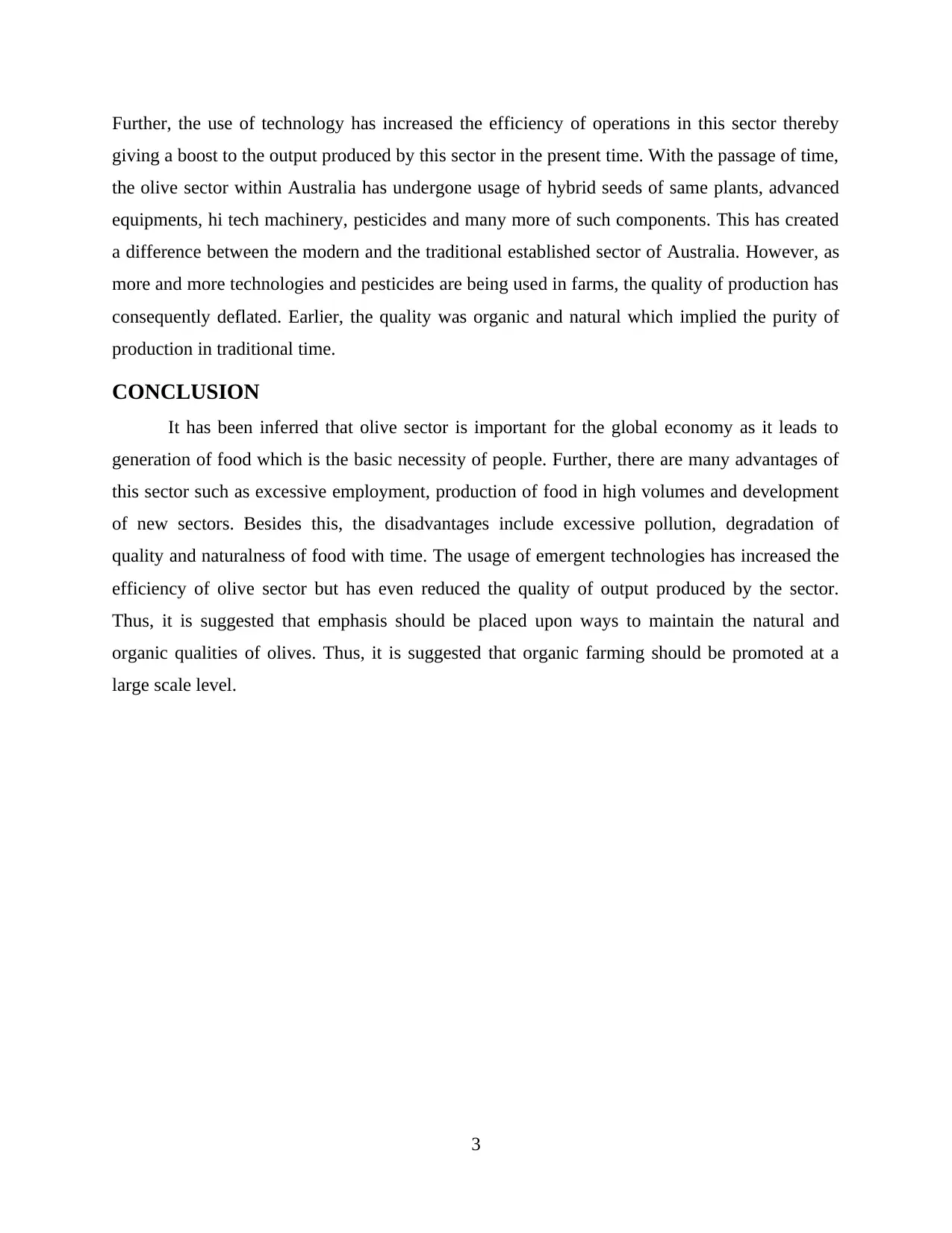
Further, the use of technology has increased the efficiency of operations in this sector thereby
giving a boost to the output produced by this sector in the present time. With the passage of time,
the olive sector within Australia has undergone usage of hybrid seeds of same plants, advanced
equipments, hi tech machinery, pesticides and many more of such components. This has created
a difference between the modern and the traditional established sector of Australia. However, as
more and more technologies and pesticides are being used in farms, the quality of production has
consequently deflated. Earlier, the quality was organic and natural which implied the purity of
production in traditional time.
CONCLUSION
It has been inferred that olive sector is important for the global economy as it leads to
generation of food which is the basic necessity of people. Further, there are many advantages of
this sector such as excessive employment, production of food in high volumes and development
of new sectors. Besides this, the disadvantages include excessive pollution, degradation of
quality and naturalness of food with time. The usage of emergent technologies has increased the
efficiency of olive sector but has even reduced the quality of output produced by the sector.
Thus, it is suggested that emphasis should be placed upon ways to maintain the natural and
organic qualities of olives. Thus, it is suggested that organic farming should be promoted at a
large scale level.
3
giving a boost to the output produced by this sector in the present time. With the passage of time,
the olive sector within Australia has undergone usage of hybrid seeds of same plants, advanced
equipments, hi tech machinery, pesticides and many more of such components. This has created
a difference between the modern and the traditional established sector of Australia. However, as
more and more technologies and pesticides are being used in farms, the quality of production has
consequently deflated. Earlier, the quality was organic and natural which implied the purity of
production in traditional time.
CONCLUSION
It has been inferred that olive sector is important for the global economy as it leads to
generation of food which is the basic necessity of people. Further, there are many advantages of
this sector such as excessive employment, production of food in high volumes and development
of new sectors. Besides this, the disadvantages include excessive pollution, degradation of
quality and naturalness of food with time. The usage of emergent technologies has increased the
efficiency of olive sector but has even reduced the quality of output produced by the sector.
Thus, it is suggested that emphasis should be placed upon ways to maintain the natural and
organic qualities of olives. Thus, it is suggested that organic farming should be promoted at a
large scale level.
3
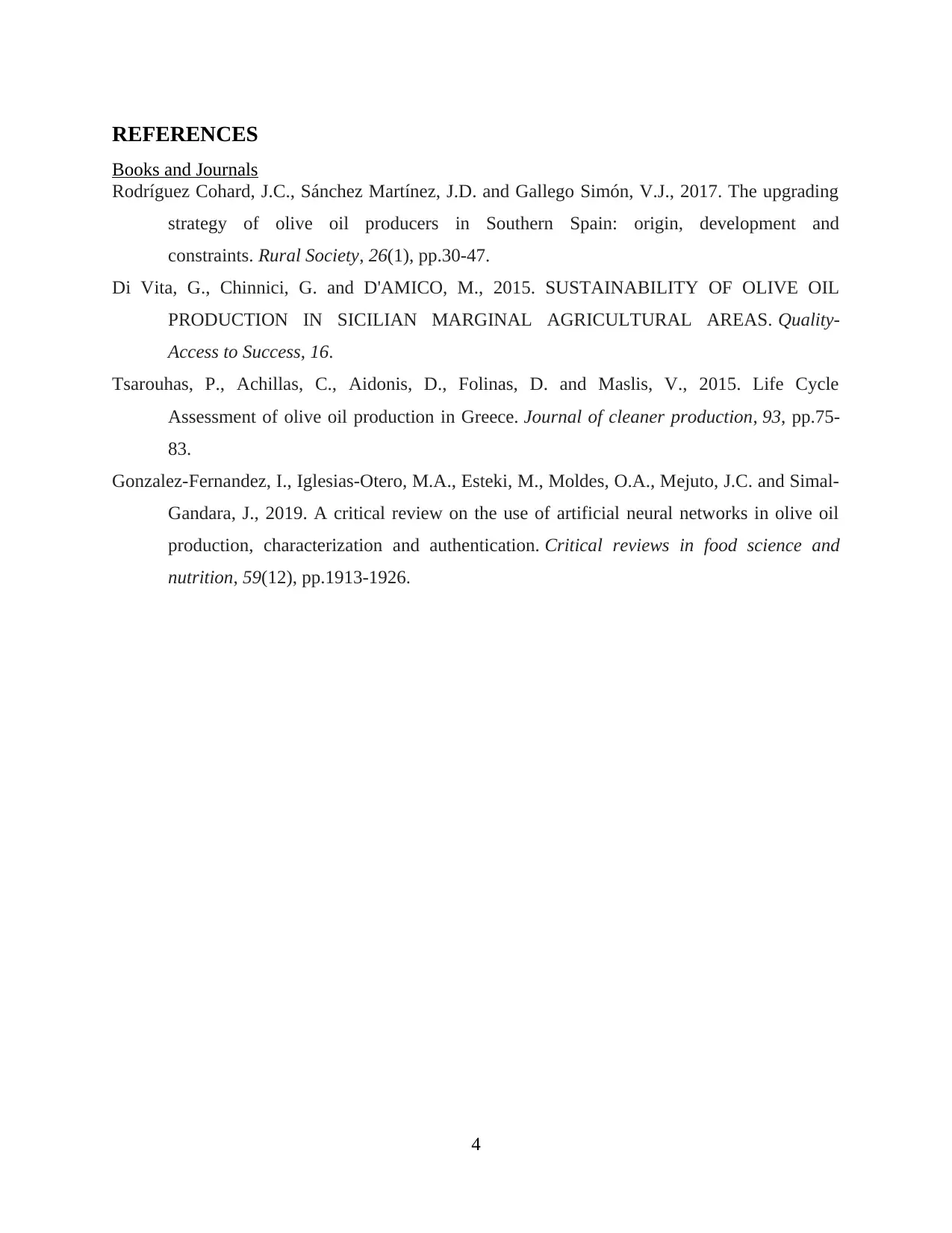
REFERENCES
Books and Journals
Rodríguez Cohard, J.C., Sánchez Martínez, J.D. and Gallego Simón, V.J., 2017. The upgrading
strategy of olive oil producers in Southern Spain: origin, development and
constraints. Rural Society, 26(1), pp.30-47.
Di Vita, G., Chinnici, G. and D'AMICO, M., 2015. SUSTAINABILITY OF OLIVE OIL
PRODUCTION IN SICILIAN MARGINAL AGRICULTURAL AREAS. Quality-
Access to Success, 16.
Tsarouhas, P., Achillas, C., Aidonis, D., Folinas, D. and Maslis, V., 2015. Life Cycle
Assessment of olive oil production in Greece. Journal of cleaner production, 93, pp.75-
83.
Gonzalez-Fernandez, I., Iglesias-Otero, M.A., Esteki, M., Moldes, O.A., Mejuto, J.C. and Simal-
Gandara, J., 2019. A critical review on the use of artificial neural networks in olive oil
production, characterization and authentication. Critical reviews in food science and
nutrition, 59(12), pp.1913-1926.
4
Books and Journals
Rodríguez Cohard, J.C., Sánchez Martínez, J.D. and Gallego Simón, V.J., 2017. The upgrading
strategy of olive oil producers in Southern Spain: origin, development and
constraints. Rural Society, 26(1), pp.30-47.
Di Vita, G., Chinnici, G. and D'AMICO, M., 2015. SUSTAINABILITY OF OLIVE OIL
PRODUCTION IN SICILIAN MARGINAL AGRICULTURAL AREAS. Quality-
Access to Success, 16.
Tsarouhas, P., Achillas, C., Aidonis, D., Folinas, D. and Maslis, V., 2015. Life Cycle
Assessment of olive oil production in Greece. Journal of cleaner production, 93, pp.75-
83.
Gonzalez-Fernandez, I., Iglesias-Otero, M.A., Esteki, M., Moldes, O.A., Mejuto, J.C. and Simal-
Gandara, J., 2019. A critical review on the use of artificial neural networks in olive oil
production, characterization and authentication. Critical reviews in food science and
nutrition, 59(12), pp.1913-1926.
4
⊘ This is a preview!⊘
Do you want full access?
Subscribe today to unlock all pages.

Trusted by 1+ million students worldwide
1 out of 6
Related Documents
Your All-in-One AI-Powered Toolkit for Academic Success.
+13062052269
info@desklib.com
Available 24*7 on WhatsApp / Email
![[object Object]](/_next/static/media/star-bottom.7253800d.svg)
Unlock your academic potential
Copyright © 2020–2025 A2Z Services. All Rights Reserved. Developed and managed by ZUCOL.





